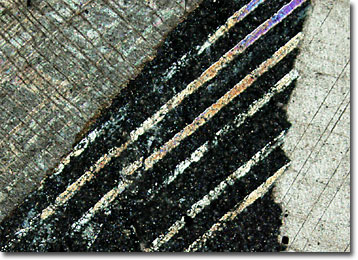Polarized Light Microscopy Digital Image Gallery
Dolomite Marble
Marble has been utilized for a wide variety of purposes for thousands of years. Though more widely known for its employment in sculpture and ornate buildings, one particularly unusual use of the material in antiquity was to create large marble disks that were fastened on the prows of boats to act as their “eyes” and help guide them through the dangerous seas.

In modern times, most any chiefly carbonate rock that achieves a nice luster when polished is referred to marble commercially. In scientific circles, however, this rock must have been metamorphosed by heat, pressure, or other influences. The majority of marbles are composed of 90 percent or more of calcite or dolomite. The other ten percent or so of the material may consist of any combination of a broad spectrum of impurities, such as quartz, diopside, tremolite, actinolite, wollastonite, sphene, and various types of garnet. It is these impurities that produce the characteristic patches, swirls, or variegations of color present in many marbles.
As indicated by its common name, dolomite marble is that which is composed primarily of the mineral dolomite. The crystalline substance, which may be gray, white, buff, bluish, reddish, or greenish in color and exhibits a pearly to subvitreous sheen, is quarried in a number of locations throughout the world, such as Finland, Wyoming, New York, Italy, and Greece. Large formations of dolomite are also found in the region of the Alps typically referred to today as the Dolomites, where the rock was first scientifically studied in late eighteenth century by Dolomieu.
